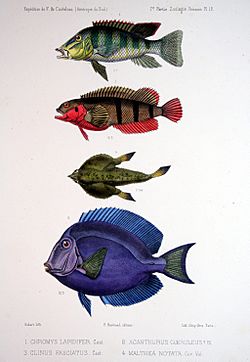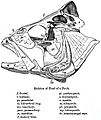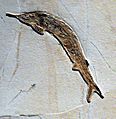Teleost facts for kids
Quick facts for kids TeleostTemporal range: Jurassic – Recent
|
|
|---|---|
 |
|
| Retroculus (Cichlidae); Hairy Blenny, Labrisomus; Ogcocephalus and Acanthurus | |
| Scientific classification | |
| Kingdom: | |
| Phylum: | |
| Subphylum: | |
| Class: | |
| Subclass: | |
| Infraclass: |
Teleostei
|
Teleosts are the most common type of fish found today. They first appeared during the Mesozoic era, which was a very long time ago. There are about 20,000 different kinds of teleost fish alive right now. This means that 96 out of every 100 fish species you know are teleosts!
The oldest teleost fossils are from the late Triassic period. These fish evolved from creatures similar to bowfins. Over time, during the Mesozoic and Cainozoic eras, teleosts changed and spread out into many different forms. This process is called diversification.
Teleosts are part of a long evolutionary journey. They are vertebrates (animals with backbones) and jawed fish. They are also bony fish and ray-finned fish.
One special thing about teleosts is their movable jaw. They have special jaw muscles that let them push their jaws outwards. This helps them grab fast-moving prey like smaller fish or insects. It makes them very good hunters!
When Did Teleosts First Appear?
Figuring out exactly when teleosts first appeared can be tricky. Scientists use two main types of clues. One clue comes from fossils, which show the first teleosts in the late Triassic period.
The other clue comes from something called a molecular clock. This method looks at changes in DNA over time to estimate when different groups of animals separated. For teleosts, both the fossil record and molecular clock estimates generally agree. This means scientists are quite sure about when these amazing fish began to thrive.
| Osteichthyes |
|
||||||||||||||||||||||||||||||||||||||||||||||||||||||
Main Groups of Teleosts
Teleosts are divided into several large groups called superorders. Each superorder contains different families and types of fish. Here are some of the main ones:
- Osteoglossomorpha: This group includes fish like freshwater elephantfish, mooneyes, and the huge Arapaima.
- Elopomorpha: This superorder is home to all kinds of eels.
- Clupeomorpha: You'll find fish like herrings and anchovies in this group.
- Ostariophysi: This is a very large group! It includes common fish like carp, goldfish, minnows, catfish, piranha, and even electric eels.
- Protacanthopterygii: This group has popular fish such as salmon, trout, and pike.
- Stenopterygii: An example from this group is the marine hatchetfish.
- Cyclosquamata: This group includes fish like the Bombay duck and lancetfish.
- Scopelomorpha: This superorder is known for lanternfish.
- Lampridiomorpha: Here you'll find interesting fish like ribbonfish.
- Polymyxiomorpha: This group includes beardfish.
- Paracanthopterygii: This superorder contains fish like cavefish, cod, and anglerfish.
- Acanthopterygii: This is the largest superorder of teleosts. It has 16 different orders! It includes fish like mullet, silverside, dory, flyingfish, stickleback, and seahorse.
Images for kids
-
Aspidorhynchus acustirostris, an early teleost from the Middle Jurassic, related to the bowfin
-
Predatory teleost: the flesh-cutting teeth of a piranha (Serrasalmidae)
-
The winter flounder is asymmetrical, with both eyes lying on the same side of the head.
-
The knifefish Gymnarchus niloticus generates weak electric fields enabling it to detect and locate prey in turbid water.
-
Fish in a hot desert: the desert pupfish
-
A stickleback stained to show the lateral line elements (neuromasts)
-
Osmotic challenge: American eels spawn in the sea but spend most of their adult life in freshwater, returning only to spawn.
-
A teleost swim bladder
-
Flying fish combine swimming movements with the ability to glide in air using their long pectoral fins.
-
Male desert goby courting a female
-
Three-spined stickleback males (red belly) build nests and compete to attract females to lay eggs in them. Males then defend and fan the eggs. Painting by Alexander Francis Lydon, 1879
-
Schooling predatory bluefin trevally sizing up schooling anchovies
-
Fish farming in the sea off Scotland
-
Capture of Atlantic Cod 1950-2005 (FAO)
-
Service to science: zebrafish being bred in a research institute
-
Wall painting of fishing, Tomb of Menna the scribe, Thebes, Ancient Egypt, c. 1422–1411 BC
-
Italian Renaissance: Fish, Antonio Tanari, c. 1610–1630, in the Medici Villa, Poggio a Caiano
-
Dutch Golden Age painting: Fish Still Life with Stormy Seas, Willem Ormea and Abraham Willaerts, 1636
-
Mandarin Fish by Bian Shoumin, Qing dynasty, 18th century
-
Still Life with Mackerel, Lemons and Tomato, Vincent Van Gogh, 1886
-
Teleostei by Ernst Haeckel, 1904. Four species, surrounded by scales
-
Fish Magic, Paul Klee, oil and watercolour varnished, 1925
See also
 In Spanish: Teleósteos para niños
In Spanish: Teleósteos para niños





























